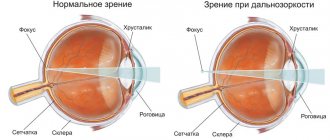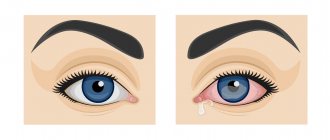Hypermetropia is a common visual impairment, which is expressed in the patient’s inability to clearly see objects located close to him. But he clearly sees objects at a long distance.
Farsightedness is a type of refraction. Light rays are focused behind the retina, resulting in an image being formed behind the retina of the eye. This leads to the fact that objects at close range look blurry and do not have clear contours.
Causes of farsightedness
Like myopia (myopia), farsightedness is caused by a violation of the optical-geometric parameters and proportions of the eyeball: either the refractive ability of the cornea and/or lens is insufficient, or the anterior-posterior axis is too short - the eye seems to be “flattened” horizontally and “stretched” vertically . In both cases, the focal point is behind the retina. There is also a combined option, when insufficient refraction is combined with shortening of the horizontal (longitudinal) axis.
Transient, so-called physiological farsightedness is observed in newborns and is considered normal if in the neonatal period it does not exceed a degree of 4 diopters. If there is congenital hypermetropia of a high or very high degree, such an anomaly is almost never isolated and is accompanied by other defects of the visual system (pathology of the vessels and optic nerve head, cataracts, aniridia, a tendency to increase intraocular pressure), various anatomical malformations, congenital neurological pathology.
Normally, the size of the eyeball gradually increases with the overall growth and development of the child’s body, and the anterior-posterior axis of the eye reaches its optimal, natural length of 23-25 mm. In the first years of life, infantile farsightedness thus regresses to a normative degree. However, sometimes the “longitudinal” growth of the eyeball does not stop in time, and the focal point turns out to be closer to the retina - myopia is formed; in other cases, on the contrary, the anterior-posterior axis remains shortened, and vision, accordingly, is farsighted.
The reasons for such “growing pains” are not entirely clear today. However, the hypermetropic refractive error in most people is compensated reflexively, by excessive contraction of the ciliary muscle, which makes it possible to give the lens a more spherical (i.e., more refractive than would be necessary with the normal geometry of the eye) shape and thereby ensure relatively clear perception of distant objects. By adulthood and old age, the ciliary muscle “gets tired” from constant tension, its elasticity and contractility decrease, and the accommodating system no longer holds the lens in the desired shape. Around the age of sixty (this age varies widely), the natural aging of eye tissues and structures leads to a variety of problems and overall deterioration of vision, both near and far. This condition of the visual system is called “presbyopia,” or senile farsightedness (for reasons of political correctness, it is more often called age-related hyperopia, or farsightedness of old age). A satisfactory quality of life is most often restored in the simplest and most affordable way - optical correction, i.e. “plus” points of one strength or another.
If myopia is always an excess of the collecting ability of the eye optics, then farsightedness is its disadvantage: the rays are refracted weaker and therefore concentrated further. Therefore, it is natural that with the complete exclusion of one of the refractive elements, the lens, farsightedness is inevitable. Aphakia, or the absence of the lens, can be a congenital abnormality or the result of injury, cataract surgery, etc. Visual acuity drops to 0.1 of the standard or even lower, which requires either powerful optical correction or implantation of an IOL (intraocular lens, i.e. artificial lens).
Congenital hypermetropia in children
If physiological farsightedness gradually disappears as the child grows, then congenital hyperopia depends on hereditary and genetic factors and is a pathology. As a rule, it is problematic to diagnose it in the early stages, up to about 5-6 years, since the degrees are still small, and a child at this age has physiological farsightedness. The causes of this violation may be the following phenomena:
- abnormal intrauterine development of the fetus due to the use of any medications, alcohol, nicotine by a pregnant woman, or an infectious disease suffered during pregnancy;
- the presence of high degrees of farsightedness in both parents.
The result of negative factors during pregnancy can be pathological changes in the structure of the child’s visual organs.
So, he may be born with microphakia. In this case, the lens is very small in size and, accordingly, will not be able to refract light rays correctly. It happens that this natural lens is completely absent in the baby’s eye - this disorder is called aphakia. Congenital pathologies can also cause farsightedness in humans. So, this disease is diagnosed in albinos in almost 90% of cases. Leber's amaurosis is a pathology of the retina that is transmitted genetically. In this case, the child experiences nystagmus, photophobia and farsightedness, which subsequently progresses. Franceschetti syndrome is characterized by abnormal development of facial bones, as well as microphthalmos, leading to the appearance of pathological farsightedness.
Symptoms of farsightedness
In young, young, early adulthood, the actual farsightedness may be asymptomatic: the state of the accommodating system allows one to compensate for optical weakness by some overvoltage, without causing the person any noticeable discomfort. However, even with preserved compensatory ability - and fairly clear near vision - hypermetropia, say, of moderate degree will manifest itself as visual fatigue, soreness of the eyeballs, headaches of a certain localization (bridge of the nose, brow ridges, forehead). Sometimes a person, especially in a state of fatigue, notices with surprise that it is more comfortable for him to read the text at arm’s length, because when approaching, the letters periodically blur or merge, and an irritating feeling of lack of light arises (previously quite sufficient). More pronounced degrees of hypermetropia may also be accompanied by sensations of pain, sand in the eyes, pressure from inside the eyeball, intense headache, and upon an objective examination by an ophthalmologist - pathological changes in the structures of the fundus.
Congenital farsightedness of a high degree requires the child’s visual system to be overstrained; The oculomotor muscular system constantly tries to bring the eyes towards the nose for clear focus. There is a high risk of consolidation of such a reflex and, as a result, the development of converging (common) strabismus. In turn, this is fraught with amblyopia (“lazy eye syndrome”), impaired binocularity, psychological trauma and many other negative consequences.
Due to the frequent involuntary urge to rub the hypermetropic eyes, just as myopic people squint, farsightedness in childhood and adolescence is often accompanied by various kinds of infections and inflammations. In adulthood and old age, farsightedness has been found to contribute to a persistent increase in intraocular pressure and the development of other glaucomatous symptoms.
What happens if farsightedness is not treated?
The presence of this pathology in itself brings discomfort to a person’s daily life. If treatment and correction are not addressed in time, the consequences can be very negative. In early childhood, advanced farsightedness causes the development of convergent strabismus and amblyopia, in addition, binocular vision suffers. This affects orientation in space and interferes with sports and games.
Hypermetropia also affects the occurrence of inflammatory diseases. The fact is that a person often rubs his eyes, thereby introducing an infection from dirty hands, as a result of which conjunctivitis, blepharitis, and keratitis develop. In addition, people with high degrees of farsightedness are at risk of developing glaucoma.
visit to the doctor. Timely therapy will relieve many dangerous consequences for vision.
Classification of farsightedness
There are a number of approaches to the classification of hypermetropia, depending on the goals and objectives of such categorization. Thus, according to the optical-geometric criterion, axial (axial) anatomical farsightedness is distinguished from refractive farsightedness associated with a deficiency of refractive power; Based on the preservation of compensatory ability, latent (hidden) and explicit variants are distinguished, and with age, the first usually transforms into the second. According to the age criterion, farsightedness is divided into normal physiological hyperopia of newborns, pathological congenital farsightedness and presbyopia.
However, for practical purposes, the severity of hypermetropia most often matters. There are three degrees of this:
- weak (0-2 diopters);
- medium (2-5 diopters);
- high (5 or more diopters).
What is eye accommodation?
sees well at long distances and close up. The mechanism of accommodation is responsible for this. Our lens is capable of changing its curvature depending on the distance of the object we are looking at. When looking into the distance, the ciliary muscle relaxes, the lens becomes flatter, its refractive power decreases, and the rays are concentrated precisely on the retina, providing clear vision. When looking at close objects, the ciliary muscle tenses, and the lens becomes more convex, and its refractive power increases, promoting good near vision.
Accommodation is the main mechanism responsible for the so-called mechanical refraction, that is, for the clear focusing of the eyes on objects at different distances. With good accommodation, small degrees of farsightedness are not even felt. Over time, the accommodative capabilities of the eye decrease, the ciliary muscle weakens, the lens loses its elasticity, and age-related farsightedness occurs—presbyopia. Even a person with normal vision begins to see worse and worse at close distances. The text and small details literally blur before his eyes. Visual deterioration with a plus sign occurs after 40-45 years of age and continues until approximately 60 years of age. We talked about accommodation in such detail in order to further understand the mechanism of presbyopia and the causes of farsightedness in general.
Diagnosis of farsightedness
In most cases, hypermetropia is detected during a planned preventive or targeted visit to an ophthalmologist. At the same time, to establish a clinical diagnosis, the complaint “I can’t see well up close” is not enough. Careful and accurate measurement of refractive indices is necessary (depending on age, skiascopy, computer refractometry, visometry - measurement of real visual acuity using interchangeable lenses, etc.) are used. To diagnose latent hypermetropia in children and young adults, most likely, you will need to dilate the pupil with one of the mydriatic drugs (the best known of which is atropine sulfate).
Geometric measurements on the eyeball (measurement of its longitudinal “length”) are carried out using a painless and safe ultrasound examination, or ultrasound.
There are also many more special diagnostic methods (gonioscopy, perimetry, tonometry, and many others) performed by an ophthalmologist depending on the specific clinical picture.
Treatment of farsightedness
Today, farsightedness is by no means an incurable disease that can only alleviate symptoms due to irreparable causes.
Along with palliative conservative correction (glasses), a number of methods have been developed to radically eliminate farsightedness as such. The two main areas are ophthalmic surgery (keratoplasty, IOL implantation, etc.) and excimer laser correction (LASEK, LASIK, Femto LASIK, etc.). In any case, treatment should be timely, and the choice of method should be based on a thorough and comprehensive study of the anamnesis, dynamics, and current clinical picture.
In the absence of pronounced discomfort that reduces the quality of life, with the preservation of normative visual acuity in both eyes and the ability for binocular perception, intervention is not indicated.
In childhood, radical correction is also not performed: they are limited to preventing further progression and prescribing adequate glasses with regular ophthalmological monitoring. Preschoolers with hypermetropia of more than 3 diopters should wear glasses at all times, and clinical observation is designed to promptly identify and prevent the development of strabismus and/or amblyopia; If the dynamics are favorable, optical correction can be canceled by the beginning of school.
For passive correction of farsightedness, not only glasses, but also contact lenses are used. Research and development continues constantly; New modern materials and models of lenses are being introduced into practice - in particular, the so-called. orthokeratological, or “night” lenses, which are worn only during sleep and relatively steadily change the shape of the cornea in such a way as to provide sufficient refraction during the day (however, such lenses are capable of correcting hypermetropia only to a degree of up to 3 diopters). In case of high farsightedness, bifocal glasses may be prescribed, or two pairs of glasses - for distance and near vision.
A very effective, but, unfortunately, not yet fully appreciated method is hardware-training treatment (devices such as “amblyokor”, “synoptophore”, “visotronic”, computerized complexes), physiotherapeutic and reflexology methods, vitamin therapy. When watching TV or working with a computer, the negative effect of congestive eye strain is reduced by using perforation glasses.
Laser correction is usually prescribed from the age of 18, but the lower and upper (45 years) age limits are not absolute or rigid. If there are no more serious contraindications (diabetes mellitus, chronic inflammatory diseases of the visual system, pregnancy or breastfeeding), laser correction becomes an effective and radical solution to the problem; the risk of complications or side effects here is lower for a number of reasons than with any other type of intervention.
Ophthalmosurgical treatment of hyperopia, including age-related, usually involves replacing a functionally incompetent lens with an intraocular lens with greater optical power (hyperartifakia), but other surgical correction techniques are also used, depending on the indications.
Our ophthalmology center carries out accurate diagnostics of farsightedness in children and adults using modern equipment from leading global manufacturers. Treatment may include the use of hardware techniques and laser methods for vision restoration. If necessary, we select contact lenses or glasses.
Why does a person develop farsightedness?
The disease can be the result of heredity (impaired development of the eyeball, lens and cornea), inevitable age-related changes, a consequence of hypertension, diabetes, and stress. Hypermetropia is usually diagnosed when several
In this article
- Why does a person develop farsightedness?
- Features of vision with farsightedness
- Explicit, complete and hidden farsightedness in adults - features
- Is hidden farsightedness dangerous to health?
- How to identify hidden hypermetropia?
- Prevention of farsightedness in adults
- How to get rid of farsightedness - methods of correction
- What to do if glasses are unacceptable to the patient for some reason?
factors. Refractive hyperopia develops if there are pathologies of the cornea or lens, and axial hyperopia occurs as a consequence of the anatomical features of the eye. Loss of accommodation can also be associated with eye injuries, degeneration of the ciliary body, ciliary body, and weakening of its contractile function. Weakening of accommodation occurs with all types of refraction. Patients with true farsightedness notice changes first. People with myopia do not experience the symptoms of age-related farsightedness for a long time. With myopia up to three diopters, correction of presbyopia is not required, since to view objects up close it is enough to remove distance glasses.
Prevention
The principles of preventing further progression of farsightedness are as simple as they are effective. They do not require any special investment of time or financial expenses, but, at the same time, they really “work” to preserve vision. We are talking, first of all, about maintaining visual hygiene (lighting, distance, work-rest cycle), performing basic eye exercises and regular visits to an ophthalmologist, who will inform you in the most detailed manner about what measures are a priority in your particular case.











